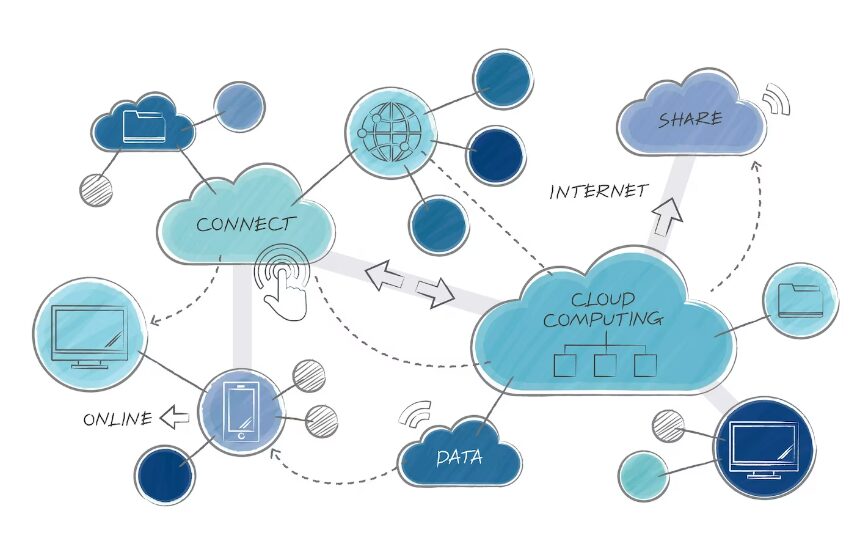Multi-cloud refers to an IT strategy that leverages multiple cloud services from various providers. Instead of relying solely on a single vendor, organizations can choose the best cloud solutions for specific needs across different public clouds, private clouds, or even on-premises infrastructure. This approach offers greater flexibility, scalability, cost optimization, and vendor independence compared to a single-cloud environment.
While hybrid cloud combines public and private cloud resources, multi-cloud specifically focuses on utilizing services from multiple public cloud providers. This allows organizations to benefit from the unique strengths and offerings of each vendor, such as specialized features, pricing models, and geographic reach.

Defining Multi-cloud: Embracing a Diverse Cloud Landscape
Demystifying the Multi-cloud Concept
At its core, multi-cloud is about breaking free from vendor lock-in and embracing a diverse cloud ecosystem. This means organizations can:
- Utilize the unique strengths and specializations of different cloud providers: Each cloud vendor offers a distinct set of services, pricing models, and geographic reach. Multi-cloud allows organizations to tap into the best offerings from each provider, such as:
- Specialized features and functionalities: Certain providers may excel in specific areas like artificial intelligence, machine learning, or data analytics.
- Competitive pricing models: By leveraging multiple providers, organizations can compare and choose the most cost-effective solutions for their needs.
- Global reach and scalability: Different providers offer varying degrees of geographic coverage, allowing organizations to cater to diverse customer bases or comply with data residency regulations.
- Enhance agility and adaptability: The ability to quickly scale resources up or down based on demand becomes easier with multi-cloud. Organizations can dynamically adapt their cloud infrastructure to meet fluctuating workloads or seize new business opportunities.
- Improve disaster recovery and fault tolerance: By distributing workloads across multiple cloud providers, organizations can mitigate the risk of outages in any single cloud environment. This redundancy ensures business continuity and minimizes downtime in case of unforeseen disruptions.
Distinguishing Multi-cloud from Hybrid Cloud
It’s crucial to differentiate between multi-cloud and hybrid cloud strategies. While both involve using multiple environments, they differ in their scope:
- Multi-cloud: Focuses on utilizing services from multiple public cloud providers.
- Hybrid cloud: Combines public cloud resources with a private cloud or on-premises infrastructure.
Therefore, multi-cloud offers a wider range of options and flexibility in selecting cloud providers, while hybrid cloud prioritizes integrating existing on-premises infrastructure with public cloud services.
The Journey Towards Multi-cloud Adoption
Embarking on a multi-cloud journey requires careful consideration. Organizations must:
- Define their business goals and requirements: Clearly understand the specific needs and challenges they aim to address through multi-cloud adoption.
- Evaluate their existing IT landscape: Assess the compatibility of current infrastructure and applications with multi-cloud environments.
- Research and compare cloud providers: Analyze the offerings, pricing models, and security features of various cloud vendors to shortlist potential partners.
Differentiating Multi-cloud from Hybrid Cloud
While both multi-cloud and hybrid cloud strategies involve leveraging multiple environments for IT infrastructure, they differ in their core focus and approach:
Scope
- Multi-cloud: Focuses on utilizing multiple public cloud services from different providers. This allows organizations to choose the best-fit solutions for specific needs across various public cloud platforms.
- Hybrid cloud: Combines public cloud resources with on-premises infrastructure or a private cloud. This approach aims to integrate existing IT assets with the scalability and flexibility of public cloud services.
Deployment Model
- Multi-cloud: Typically involves independent deployments across different public clouds. Each cloud environment operates separately, with potential integrations between them for specific functionalities.
- Hybrid cloud: Creates a connected and integrated environment between public cloud resources and the on-premises infrastructure. This allows for seamless data flow and application execution across both environments.
Management Complexity
- Multi-cloud: Managing multiple public cloud environments with different interfaces and tools can be more complex. Organizations need robust cloud management platforms and skilled personnel to navigate diverse cloud ecosystems.
- Hybrid cloud: While still requiring management across different environments, hybrid cloud complexity can be relatively lower due to the integration and potential standardization within the organization’s own infrastructure.
Security Considerations
- Multi-cloud: Requires consistent security policies and practices to be implemented across diverse public cloud platforms. This ensures uniform data protection and access control across the entire multi-cloud landscape.
- Hybrid cloud: Security considerations involve securing both the public cloud environment and the on-premises infrastructure, along with ensuring secure communication and data transfer between them.
Vendor Lock-in
- Multi-cloud: Offers greater vendor independence as workloads and applications can be distributed across different public cloud providers. This reduces reliance on a single vendor and allows for switching based on evolving needs or pricing models.
- Hybrid cloud: May introduce vendor lock-in if specific functionalities or integrations heavily rely on the chosen public cloud provider. However, the on-premises infrastructure provides some level of independence.
Choosing the Right Approach
The decision between multi-cloud and hybrid cloud depends on individual organizational needs and priorities. Organizations with existing on-premises infrastructure and a desire for tight integration might favor a hybrid approach. Conversely, those seeking flexibility, vendor independence, and access to specialized public cloud services may find multi-cloud more suitable.
Expanding on the Benefits of Multi-cloud
Flexibility and Choice
- Matching specific needs: Multi-cloud allows you to choose the best-of-breed cloud services for each specific task. For example, you could use one provider for its high-performance computing capabilities for demanding simulations, while using another for its cost-effective storage for static data archives.
- Avoiding vendor lock-in: By diversifying your cloud providers, you avoid becoming dependent on a single vendor’s pricing, features, and service level agreements. This gives you greater negotiating power and the ability to switch providers if needed.
- Supporting diverse workloads: Multi-cloud caters to different application requirements. You can leverage cloud-native services for agile development and deployment of modern applications, while using established providers for legacy applications that require stability and security.
Scalability and Agility
- Elastic resource provisioning: Multi-cloud enables you to quickly scale resources up or down based on fluctuating demands. This allows you to pay only for the resources you use, optimizing costs and avoiding overprovisioning.
- Geographic reach and redundancy: By utilizing multiple cloud providers with geographically distributed data centers, you can ensure high availability and low latency for your applications, catering to a global audience.
- Workload portability: Containerization technologies and cloud-native architectures facilitate easier migration and deployment of workloads across different cloud environments, fostering agility and flexibility.
Cost Optimization
- Competitive pricing models: Multi-cloud allows you to leverage the diverse pricing structures offered by different providers. You can choose cost-effective options for specific needs and negotiate better deals by having the option to switch providers.
- Right-sizing resources: By selecting the most suitable cloud service for each task, you can avoid paying for unnecessary features or overprovisioned resources. This granular control over resource allocation leads to cost savings.
- Avoiding vendor lock-in: As mentioned earlier, multi-cloud prevents vendor lock-in, allowing you to take advantage of competitive pricing from different providers and avoid being tied to expensive contracts or limited service options.
Improved Disaster Recovery
- Redundancy and failover: Multi-cloud provides built-in redundancy by distributing your applications and data across multiple cloud providers. In case of an outage in one cloud environment, your applications can failover to another, minimizing downtime and ensuring business continuity.
- Geographic dispersion: Utilizing geographically distributed cloud data centers reduces the risk of a single regional outage impacting your entire infrastructure. This enhances disaster preparedness and ensures data availability even in case of localized disruptions.
- Improved recovery time objectives (RTOs) and recovery point objectives (RPOs): By having multiple cloud environments in place, you can achieve faster recovery times and minimize data loss in case of incidents. This ensures minimal disruption to your operations and protects critical business data.
Innovation and Access to Advanced Features
- Leveraging cutting-edge services: Multi-cloud allows you to access the latest advancements and innovative features offered by different cloud providers. This gives you access to a wider range of functionalities and capabilities that can enhance your applications and drive business value.
- Staying ahead of the curve: By not being confined to a single vendor, you can benefit from the continuous innovation happening across the cloud landscape. This ensures you have access to the latest technologies and features to stay competitive and adapt to evolving business needs.
- Experimentation and exploration: Multi-cloud facilitates experimentation with different cloud services and features without being restricted to a single provider’s offerings. This allows you to explore new technologies and identify the best solutions for your specific requirements.
Challenges of Multi-cloud
Complexity and Management Overhead
- Multi-cloud environments introduce additional complexity compared to single-cloud deployments. Managing multiple cloud providers with their own interfaces, tools, and billing structures requires significant expertise and resources.
- Coordinating and maintaining consistent configurations across different cloud platforms can be challenging, especially for organizations with limited IT staff or experience in cloud management.
- Monitoring performance, security, and resource utilization across diverse environments necessitates robust tools and processes to ensure visibility and control.
Security Concerns
- Maintaining consistent security posture across multiple cloud providers requires careful planning and implementation of security controls. Organizations need to ensure data encryption, access controls, and threat detection mechanisms are aligned across all cloud environments.
- Compliance with industry regulations and data privacy laws becomes more complex in a multi-cloud setting. Organizations need to understand the specific requirements of each cloud provider and ensure data residency and access controls comply with relevant regulations.
- Managing user access and identity across different cloud platforms requires additional considerations to prevent unauthorized access and data breaches.
Vendor Lock-in within Specific Cloud Services
- While multi-cloud promotes vendor independence, there’s a potential for lock-in within specific cloud services. Organizations may become reliant on unique features or functionalities offered by a particular vendor, making it difficult or costly to migrate to another provider.
- Data portability challenges can arise when relying on proprietary data formats or APIs specific to a cloud provider. This can hinder migration and limit flexibility in the future.
- Developing expertise in specific cloud platforms can create dependencies on vendor-specific skills and knowledge, making it challenging to switch providers if needed.
Data Governance and Compliance
- Ensuring data privacy and adhering to compliance regulations across multiple cloud environments requires a comprehensive data governance strategy. Organizations need to establish clear policies and procedures for data access, storage, and disposal across all cloud platforms.
- Meeting data residency requirements can be complex in a multi-cloud environment, as data may be distributed across different geographic locations based on the chosen cloud providers.
- Auditing and reporting on compliance becomes more intricate, requiring organizations to track data activities and demonstrate adherence to regulations across diverse cloud environments.

Key Components of a Multi-cloud Strategy
Cloud Service Selection
- 1. Identifying Needs and Criteria
- Business Requirements: Clearly define the specific needs of your organization, such as scalability, performance, security, compliance, and budget constraints.
- Workload Characteristics: Analyze the characteristics of each workload (e.g., compute-intensive, data-intensive, latency-sensitive) to determine the most suitable cloud environment.
- Vendor Offerings: Evaluate the strengths and weaknesses of different cloud providers in terms of services, pricing models, geographic reach, and support options.
- 2. Conducting a thorough evaluation
- Proof of Concepts (POCs): Conduct trials with potential cloud providers to assess their capabilities and compatibility with your specific needs.
- Benchmarking: Compare pricing models, performance metrics, and service features across different providers.
- Security Audits: Evaluate the security posture and compliance certifications offered by each cloud provider.
- 3. Selecting the Right Partners
- Prioritize a balanced approach: Consider factors beyond just cost, such as vendor lock-in, innovation potential, and long-term commitment.
- Establish clear SLAs (Service Level Agreements): Define performance guarantees, uptime expectations, and support responsibilities with each provider.
- Build strong relationships with cloud providers: Foster open communication and collaboration to ensure successful implementation and ongoing support.
Workload Placement
- 1. Mapping workloads to cloud environments
- Cost Optimization: Allocate workloads to cost-effective cloud environments based on resource requirements and usage patterns.
- Performance and Scalability: Deploy latency-sensitive applications in geographically distributed cloud regions for optimal performance and scalability.
- Compliance and Data Residency: Consider data residency regulations and choose cloud providers that comply with relevant requirements.
- 2. Hybrid and multi-cloud considerations
- Integration with on-premises infrastructure: Ensure seamless communication and data exchange between cloud environments and existing IT systems.
- Containerization and orchestration: Leverage containerization technologies like Docker and Kubernetes to facilitate workload portability and consistent deployment across different clouds.
Cloud Management Tools
- 1. Choosing the right tools
- Multi-cloud management platforms (MCPs): Centralize monitoring, provisioning, and governance across diverse cloud environments.
- Cloud cost management tools: Optimize cloud spending by identifying cost inefficiencies and recommending optimization strategies.
- Infrastructure as Code (IaC) tools: Automate infrastructure provisioning and configuration for consistent and repeatable deployments across clouds.
- 2. Benefits of cloud management tools
- Reduced complexity: Simplify management tasks and streamline operations across multiple cloud platforms.
- Improved visibility and control: Gain centralized insights into resource utilization, performance, and security across the multi-cloud landscape.
- Enhanced agility and efficiency: Automate repetitive tasks and accelerate cloud deployments.
API Integration and Data Portability
- 1. API integration strategies
- RESTful APIs: Leverage standardized APIs for programmatic interaction and data exchange between different cloud services.
- Cloud provider-specific APIs: Utilize vendor-specific APIs to access unique functionalities and features offered by individual cloud platforms.
- Integration platforms as a service (iPaaS): Simplify API integration by providing a unified platform for managing and connecting diverse APIs.
- 2. Ensuring data portability
- Standardized data formats: Adopt common data formats like JSON or XML to facilitate seamless data transfer between cloud environments.
- Data governance and compliance: Implement robust data governance policies and procedures to ensure data security, privacy, and compliance across the multi-cloud landscape.
Security Considerations
- 1. Implementing a comprehensive security strategy
- Identity and Access Management (IAM): Establish strong access controls and granular permissions for users and applications across all cloud environments.
- Data encryption: Encrypt data at rest and in transit to protect sensitive information from unauthorized access.
- Security monitoring and threat detection: Continuously monitor cloud environments for suspicious activities and potential security breaches.
- 2. Maintaining consistency across clouds
- Standardized security policies: Implement consistent security policies and procedures across all cloud providers to ensure uniform protection.
- Security automation tools: Utilize automation tools to streamline security tasks and enforce consistent security configurations across different cloud environments.
- Collaboration with cloud providers: Work closely with cloud providers to leverage their security expertise and benefit from their built-in security features.

Implementing a Multi-cloud Strategy
Planning and assessment
- Defining business goals and requirements:
- Clearly articulate the specific objectives and desired outcomes of the multi-cloud strategy.
- Identify key performance indicators (KPIs) to measure success, such as cost savings, performance improvement, and agility gains.
- Consider factors like regulatory compliance, data security needs, and scalability requirements.
- Evaluating existing IT infrastructure and applications:
- Analyze the current IT landscape, including on-premises infrastructure, existing cloud deployments, and application dependencies.
- Assess the suitability of existing applications for migration or modernization in a multi-cloud environment.
- Identify potential challenges related to data migration, integration, and security.
- Identifying potential cloud providers and services:
- Research and evaluate different cloud providers based on their offerings, pricing models, security posture, and geographical reach.
- Consider factors like vendor lock-in potential, service level agreements (SLAs), and support options.
- Shortlist providers that best align with specific needs for different workloads and applications.
Design and architecture
- Designing the multi-cloud architecture based on chosen providers and services:
- Define the overall architecture, including the distribution of workloads across different cloud environments.
- Consider factors like data residency requirements, latency concerns, and disaster recovery strategies.
- Design secure and scalable network connectivity between cloud environments and on-premises infrastructure.
- Defining data flow and integration between cloud environments:
- Establish clear data ownership and access controls across different cloud platforms.
- Design data pipelines and integration mechanisms to ensure seamless communication and data exchange.
- Implement robust security measures to protect sensitive data during transfer and storage across clouds.
- Establishing security protocols and access controls:
- Develop a comprehensive security strategy encompassing all cloud environments and on-premises infrastructure.
- Implement identity and access management (IAM) policies to control user access and permissions.
- Utilize cloud-native security features and tools offered by each provider to enhance protection.
Deployment and migration
- Migrating workloads and applications to the chosen cloud environments:
- Develop a migration plan considering factors like application complexity, downtime tolerance, and resource requirements.
- Utilize migration tools and techniques like lift-and-shift, refactoring, or containerization as appropriate.
- Conduct thorough testing and validation before transitioning applications to production environments.
- Implementing cloud management tools and automation:
- Leverage cloud management platforms (CMPs) to automate provisioning, monitoring, and governance across multiple clouds.
- Utilize infrastructure as code (IaC) tools to automate infrastructure deployment and configuration management.
- Implement continuous integration and continuous delivery (CI/CD) pipelines for efficient application development and deployment.
- Testing and validating the multi-cloud deployment:
- Conduct thorough testing of applications, integrations, and security controls in the multi-cloud environment.
- Perform load testing and stress testing to ensure scalability and performance under various conditions.
- Validate disaster recovery procedures to ensure seamless failover and data recovery in case of outages.
Ongoing management and optimization
- Monitoring performance, security, and costs across all cloud environments:
- Continuously monitor cloud resource utilization, application performance, and security metrics.
- Utilize cloud provider dashboards and monitoring tools for proactive problem identification and resolution.
- Track cloud spending and identify opportunities for cost optimization through reserved instances, rightsizing resources, and negotiating with providers.
- Optimizing resource utilization and cloud service subscriptions:
- Regularly review and adjust cloud resource allocation based on changing workload demands.
- Utilize autoscaling features offered by cloud providers to automatically scale resources up or down as needed.
- Analyze cloud service subscriptions and identify opportunities to renegotiate pricing or switch to more cost-effective options.
- Continuously adapting the multi-cloud strategy based on evolving needs and technologies:
- Regularly review and update the multi-cloud strategy to align with evolving business needs, technological advancements, and security threats.
- Stay informed about emerging cloud technologies and evaluate their potential benefits for the multi-cloud environment.
- Be prepared to adapt the strategy and architecture as necessary to maintain a secure, efficient, and cost-effective multi-cloud infrastructure.

Use Cases and Examples of Multi-cloud
Disaster Recovery and High Availability
- Scenario: A company relies solely on a single cloud provider for its critical business applications. If an outage occurs within that provider’s infrastructure, the company’s entire operation could be disrupted, leading to significant downtime and financial losses.
- Multi-cloud Solution: By replicating critical applications and data across multiple cloud providers, the company can ensure high availability and minimize downtime in case of disruptions. If one cloud provider experiences an outage, the applications can seamlessly failover to the other provider, maintaining operational continuity.
- Example: A healthcare organization utilizes AWS for its core patient data storage and Microsoft Azure for its disaster recovery environment. This ensures that patient data remains secure and accessible even if an outage occurs within one cloud provider.
Building and Deploying Modern Applications
- Scenario: A company needs to develop and deploy a highly scalable and agile e-commerce platform to handle fluctuating customer traffic.
- Multi-cloud Solution: By leveraging containerization technologies and cloud-native services from various providers, the company can build and deploy the application in a modular and flexible manner. This allows for independent scaling of different application components based on real-time demand, optimizing resource utilization and cost efficiency.
- Example: A retail company utilizes AWS for its compute resources and Google Cloud Platform for its container orchestration platform (Kubernetes). This combination allows them to build and deploy highly scalable microservices for their e-commerce platform, ensuring smooth operation during peak shopping seasons.
Optimizing Costs for Specific Workloads
- Scenario: A company has diverse workloads with varying resource requirements. Some workloads are compute-intensive, while others require high storage capacity.
- Multi-cloud Solution: By utilizing different cloud providers with specialized offerings, the company can optimize costs for each workload. For instance, they can leverage a cloud provider with competitive pricing for compute-intensive workloads and another provider with cost-effective storage solutions.
- Example: A media company utilizes AWS for its compute-intensive video processing tasks and utilizes a different cloud provider with lower storage costs for archiving historical data. This approach helps them optimize their overall cloud expenditure without compromising performance.
Utilizing Specialized Features from Different Providers
- Scenario: A company requires specific functionalities for its AI and machine learning applications that are not readily available within a single cloud provider.
- Multi-cloud Solution: By adopting a multi-cloud strategy, the company can access specialized features and services offered by different vendors. This allows them to leverage the unique strengths of each platform and build innovative applications that cater to their specific needs.
- Example: A research institution utilizes Microsoft Azure for its advanced machine learning tools and Google Cloud Platform for its powerful AI accelerators. This combination allows them to conduct complex research projects that require both cutting-edge AI algorithms and high-performance computing resources.
Adhering to Compliance Regulations
- Scenario: A company operates in a heavily regulated industry with strict data residency requirements. They need to ensure that sensitive data remains within specific geographical boundaries.
- Multi-cloud Solution: By choosing cloud providers with regional data centers in compliant locations, the company can adhere to data residency regulations and maintain data sovereignty. Additionally, implementing robust security measures across all cloud environments is crucial for ensuring data privacy and compliance.
- Example: A financial institution utilizes a multi-cloud strategy with cloud providers that offer data centers within specific regions mandated by financial regulations. This ensures that customer financial data remains within compliant jurisdictions and adheres to data privacy laws.

The Future of Multi-cloud
Trends and advancements in multi-cloud technologies
- Containerization and orchestration platforms: These technologies like Docker and Kubernetes are revolutionizing multi-cloud deployments. Containers package applications with all their dependencies, ensuring consistent execution across different cloud environments. Orchestration platforms like Kubernetes automate container deployment, scaling, and management, simplifying multi-cloud operations.
- Multi-cloud management platforms: Recognizing the complexity of managing diverse cloud environments, vendors are developing dedicated multi-cloud management platforms. These platforms offer a unified interface for provisioning, monitoring, and governing resources across multiple clouds. They also automate tasks like workload migration, cost optimization, and compliance enforcement, streamlining multi-cloud operations.
- Standardization and interoperability initiatives: Industry bodies and cloud providers are collaborating to establish common standards for APIs, data formats, and security protocols. This fosters seamless integration and data exchange between different cloud platforms, enabling businesses to leverage best-of-breed services from various providers without vendor lock-in.
Impact of multi-cloud on various aspects of IT
- Agility and Innovation: Multi-cloud empowers businesses to select the most suitable cloud services for specific workloads, fostering agility and innovation. They can leverage specialized AI/ML services from one provider, high-performance computing resources from another, and cost-effective storage from a third, all within a unified environment.
- Scalability and Resilience: Multi-cloud enables elastic scaling by leveraging the combined capacity of multiple providers. This ensures smooth handling of fluctuating workloads and avoids dependence on a single vendor’s capacity limitations. Additionally, multi-cloud enhances disaster recovery capabilities. By distributing workloads across geographically diverse cloud regions, businesses can mitigate the impact of outages or disruptions in specific locations.
- Cost Optimization: Multi-cloud allows businesses to leverage the competitive pricing offered by different providers. They can negotiate better deals, take advantage of spot instances, and avoid vendor lock-in, leading to significant cost savings.
- Security and Compliance: While managing security across multiple clouds adds complexity, it also offers advantages. Businesses can distribute sensitive data and workloads across different providers, reducing the impact of security breaches in any single environment. Additionally, multi-cloud allows businesses to comply with diverse data residency and regulatory requirements by choosing cloud providers with compliant offerings in specific regions.
Challenges and considerations for successful multi-cloud adoption
- Complexity: Managing multiple cloud environments requires robust tools, skilled personnel, and well-defined governance processes.
- Security: Implementing consistent security policies and controls across diverse cloud platforms is crucial to mitigate risks.
- Vendor lock-in: Careful planning and vendor selection are essential to avoid becoming overly reliant on specific cloud providers.
- Standardization: The evolving landscape of multi-cloud standards necessitates continuous adaptation and integration efforts.
Conclusion
The multi-cloud future presents immense opportunities for businesses to enhance agility, scalability, cost-efficiency, and security. By embracing advancements in multi-cloud technologies, addressing the associated challenges, and implementing a well-defined strategy, organizations can unlock the full potential of this transformative approach to cloud computing.